Statistical Modelling Assignment: Gender Wage Gap Analysis
VerifiedAdded on 2021/06/17
|9
|1909
|34
Report
AI Summary
This statistical modelling assignment investigates gender-based wage discrimination in Australia using both secondary data from the Australian Taxation Office (ATO) and primary data collected through a survey. The analysis begins with descriptive statistics, examining the distribution of occupations, wages, and deductions, and visualizing relationships through bar graphs and scatterplots. Inferential statistics, including z-tests and t-tests, are then employed to test hypotheses about wage equality and proportions of male employees in specific occupations. The report concludes that there is evidence of gender-based wage discrimination in Australia, as the wages of female employees are significantly lower than those of male employees. The study acknowledges limitations, such as the lack of occupation-specific wage comparisons, and suggests further research to provide a more comprehensive understanding of the issue. The assignment provides a detailed analysis of the wage gap in Australia utilizing a variety of statistical methods.
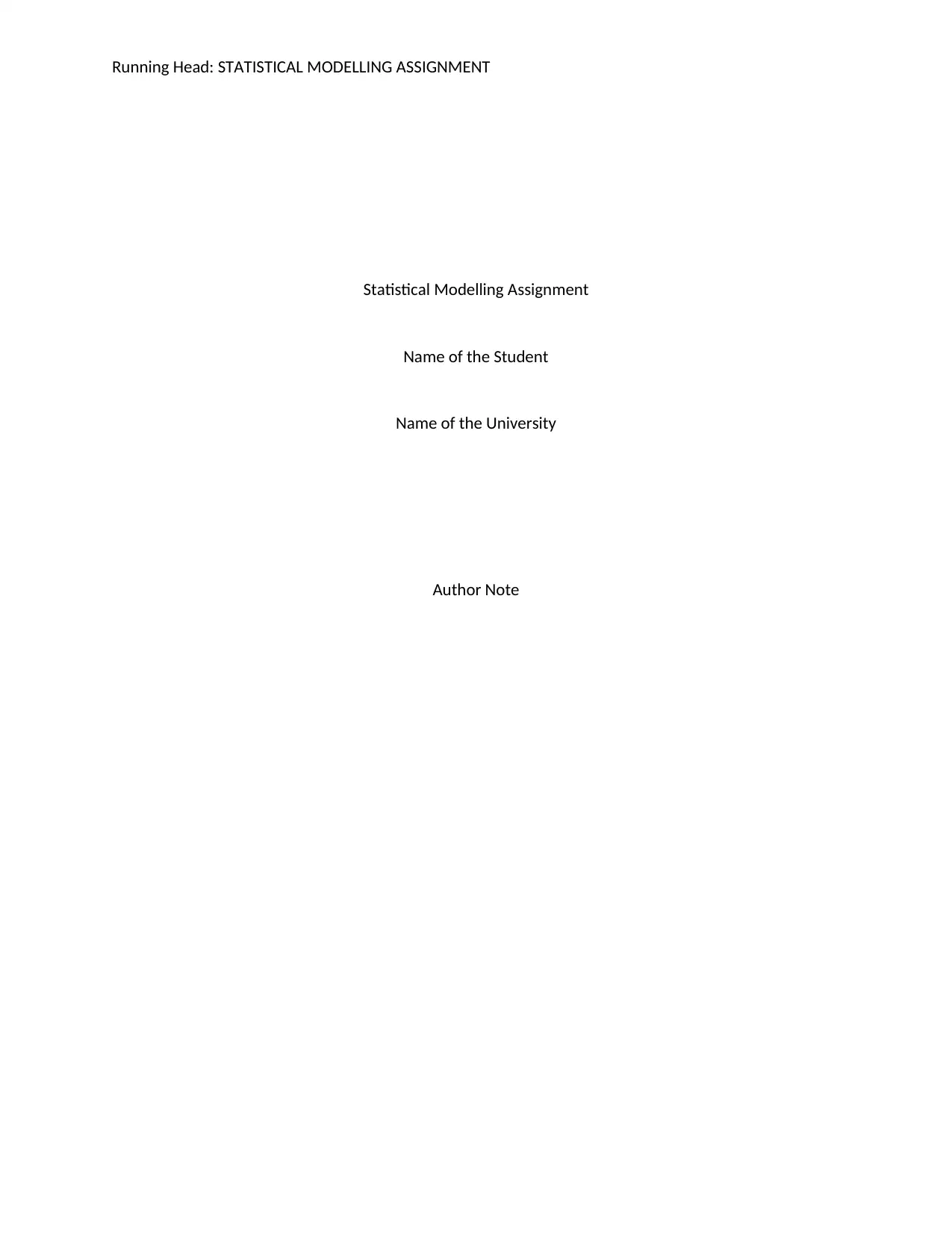
Running Head: STATISTICAL MODELLING ASSIGNMENT
Statistical Modelling Assignment
Name of the Student
Name of the University
Author Note
Statistical Modelling Assignment
Name of the Student
Name of the University
Author Note
Paraphrase This Document
Need a fresh take? Get an instant paraphrase of this document with our AI Paraphraser
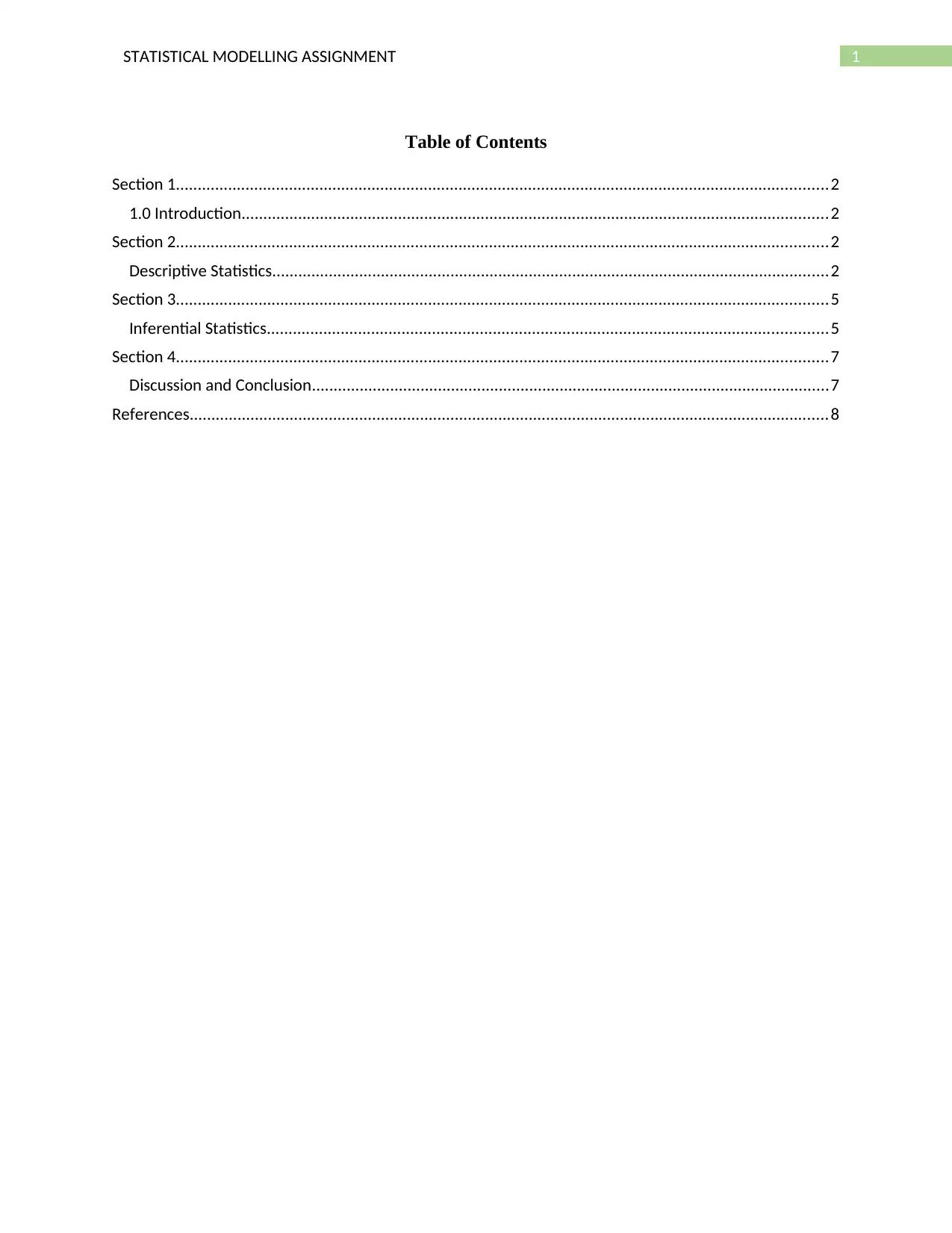
1STATISTICAL MODELLING ASSIGNMENT
Table of Contents
Section 1......................................................................................................................................................2
1.0 Introduction.......................................................................................................................................2
Section 2......................................................................................................................................................2
Descriptive Statistics................................................................................................................................2
Section 3......................................................................................................................................................5
Inferential Statistics.................................................................................................................................5
Section 4......................................................................................................................................................7
Discussion and Conclusion.......................................................................................................................7
References...................................................................................................................................................8
Table of Contents
Section 1......................................................................................................................................................2
1.0 Introduction.......................................................................................................................................2
Section 2......................................................................................................................................................2
Descriptive Statistics................................................................................................................................2
Section 3......................................................................................................................................................5
Inferential Statistics.................................................................................................................................5
Section 4......................................................................................................................................................7
Discussion and Conclusion.......................................................................................................................7
References...................................................................................................................................................8
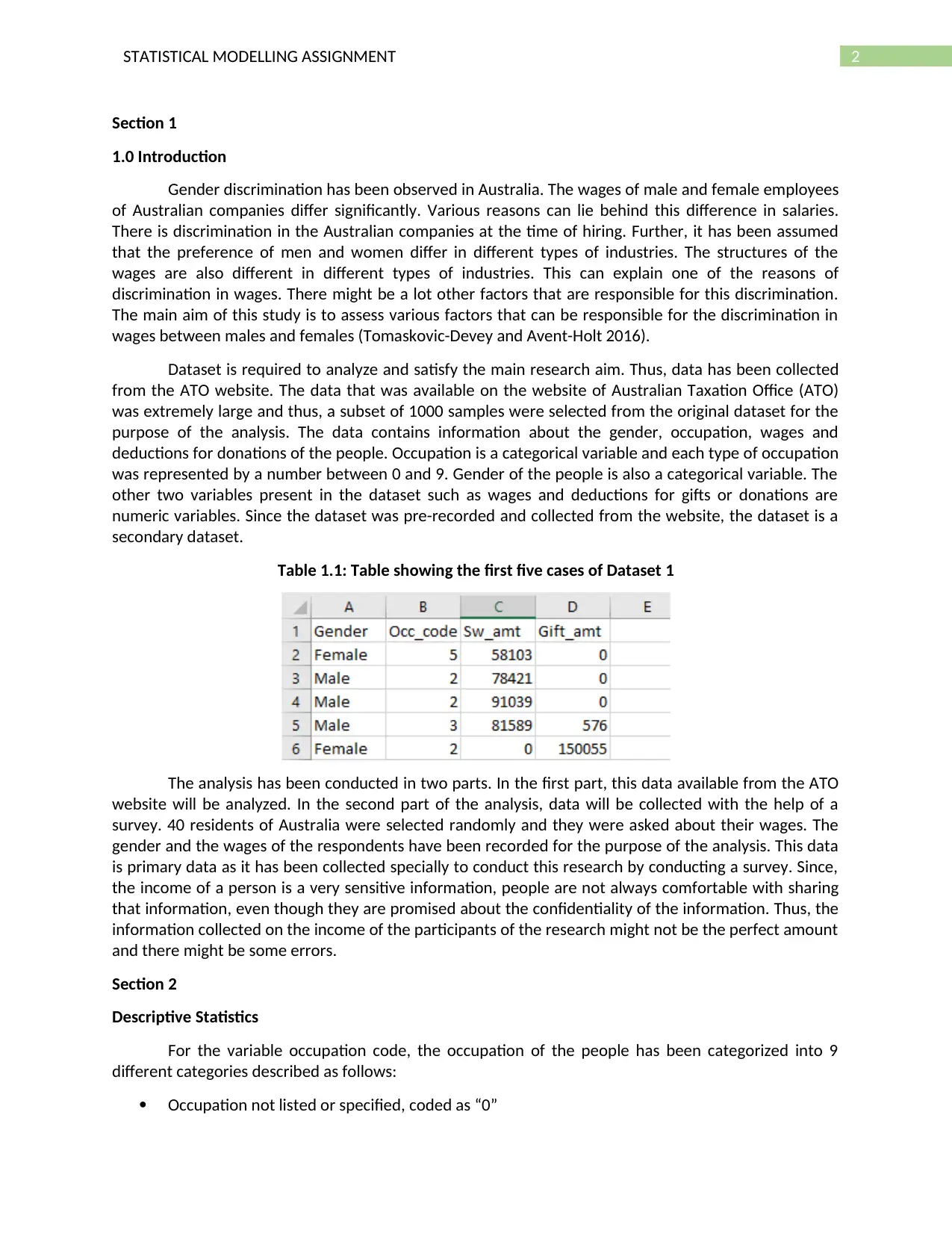
2STATISTICAL MODELLING ASSIGNMENT
Section 1
1.0 Introduction
Gender discrimination has been observed in Australia. The wages of male and female employees
of Australian companies differ significantly. Various reasons can lie behind this difference in salaries.
There is discrimination in the Australian companies at the time of hiring. Further, it has been assumed
that the preference of men and women differ in different types of industries. The structures of the
wages are also different in different types of industries. This can explain one of the reasons of
discrimination in wages. There might be a lot other factors that are responsible for this discrimination.
The main aim of this study is to assess various factors that can be responsible for the discrimination in
wages between males and females (Tomaskovic-Devey and Avent-Holt 2016).
Dataset is required to analyze and satisfy the main research aim. Thus, data has been collected
from the ATO website. The data that was available on the website of Australian Taxation Office (ATO)
was extremely large and thus, a subset of 1000 samples were selected from the original dataset for the
purpose of the analysis. The data contains information about the gender, occupation, wages and
deductions for donations of the people. Occupation is a categorical variable and each type of occupation
was represented by a number between 0 and 9. Gender of the people is also a categorical variable. The
other two variables present in the dataset such as wages and deductions for gifts or donations are
numeric variables. Since the dataset was pre-recorded and collected from the website, the dataset is a
secondary dataset.
Table 1.1: Table showing the first five cases of Dataset 1
The analysis has been conducted in two parts. In the first part, this data available from the ATO
website will be analyzed. In the second part of the analysis, data will be collected with the help of a
survey. 40 residents of Australia were selected randomly and they were asked about their wages. The
gender and the wages of the respondents have been recorded for the purpose of the analysis. This data
is primary data as it has been collected specially to conduct this research by conducting a survey. Since,
the income of a person is a very sensitive information, people are not always comfortable with sharing
that information, even though they are promised about the confidentiality of the information. Thus, the
information collected on the income of the participants of the research might not be the perfect amount
and there might be some errors.
Section 2
Descriptive Statistics
For the variable occupation code, the occupation of the people has been categorized into 9
different categories described as follows:
Occupation not listed or specified, coded as “0”
Section 1
1.0 Introduction
Gender discrimination has been observed in Australia. The wages of male and female employees
of Australian companies differ significantly. Various reasons can lie behind this difference in salaries.
There is discrimination in the Australian companies at the time of hiring. Further, it has been assumed
that the preference of men and women differ in different types of industries. The structures of the
wages are also different in different types of industries. This can explain one of the reasons of
discrimination in wages. There might be a lot other factors that are responsible for this discrimination.
The main aim of this study is to assess various factors that can be responsible for the discrimination in
wages between males and females (Tomaskovic-Devey and Avent-Holt 2016).
Dataset is required to analyze and satisfy the main research aim. Thus, data has been collected
from the ATO website. The data that was available on the website of Australian Taxation Office (ATO)
was extremely large and thus, a subset of 1000 samples were selected from the original dataset for the
purpose of the analysis. The data contains information about the gender, occupation, wages and
deductions for donations of the people. Occupation is a categorical variable and each type of occupation
was represented by a number between 0 and 9. Gender of the people is also a categorical variable. The
other two variables present in the dataset such as wages and deductions for gifts or donations are
numeric variables. Since the dataset was pre-recorded and collected from the website, the dataset is a
secondary dataset.
Table 1.1: Table showing the first five cases of Dataset 1
The analysis has been conducted in two parts. In the first part, this data available from the ATO
website will be analyzed. In the second part of the analysis, data will be collected with the help of a
survey. 40 residents of Australia were selected randomly and they were asked about their wages. The
gender and the wages of the respondents have been recorded for the purpose of the analysis. This data
is primary data as it has been collected specially to conduct this research by conducting a survey. Since,
the income of a person is a very sensitive information, people are not always comfortable with sharing
that information, even though they are promised about the confidentiality of the information. Thus, the
information collected on the income of the participants of the research might not be the perfect amount
and there might be some errors.
Section 2
Descriptive Statistics
For the variable occupation code, the occupation of the people has been categorized into 9
different categories described as follows:
Occupation not listed or specified, coded as “0”
⊘ This is a preview!⊘
Do you want full access?
Subscribe today to unlock all pages.

Trusted by 1+ million students worldwide

3STATISTICAL MODELLING ASSIGNMENT
Managers, coded as “1”
Professionals, coded as “2”
Technicians and Tech Administrative workers, coded as “3”
Community and Personal Service Workers, coded as “4”
Clerical and Administrative Workers, coded as “5”
Sales Workers, coded as “6”
Machinery operators and Drivers, coded as “7”
Laborers, coded as “8”
Consultants, apprentices and type not specified, coded as “9”
With the help of the bar graph given in figure 2.1, the relationship between gender and
occupation can be established. It can be seen clearly from the graph that women employees are given
more preference over the occupations such as clerical and administrative work, or their occupation is
not listed. It is known that the salary in these sectors are not that high. It can also be seen that the
number of women working is higher than that of men in some other occupations such as professionals,
community and personal services and sales.
0 1 2 3 4 5 6 7 8 9
0
20
40
60
80
100
120
Number of Male and Female Employees in
different Occupations
Female
Male
Occupation Code
Number of Employees
Figure 2.1
The relationship between gender and wages of the Australian residents is established with the
help of the bar graph given in figure 2.2. From the figure, it can be seen clearly that the average wage of
the female employees is considerably lower than the average wages of the male employees in Australia.
Managers, coded as “1”
Professionals, coded as “2”
Technicians and Tech Administrative workers, coded as “3”
Community and Personal Service Workers, coded as “4”
Clerical and Administrative Workers, coded as “5”
Sales Workers, coded as “6”
Machinery operators and Drivers, coded as “7”
Laborers, coded as “8”
Consultants, apprentices and type not specified, coded as “9”
With the help of the bar graph given in figure 2.1, the relationship between gender and
occupation can be established. It can be seen clearly from the graph that women employees are given
more preference over the occupations such as clerical and administrative work, or their occupation is
not listed. It is known that the salary in these sectors are not that high. It can also be seen that the
number of women working is higher than that of men in some other occupations such as professionals,
community and personal services and sales.
0 1 2 3 4 5 6 7 8 9
0
20
40
60
80
100
120
Number of Male and Female Employees in
different Occupations
Female
Male
Occupation Code
Number of Employees
Figure 2.1
The relationship between gender and wages of the Australian residents is established with the
help of the bar graph given in figure 2.2. From the figure, it can be seen clearly that the average wage of
the female employees is considerably lower than the average wages of the male employees in Australia.
Paraphrase This Document
Need a fresh take? Get an instant paraphrase of this document with our AI Paraphraser
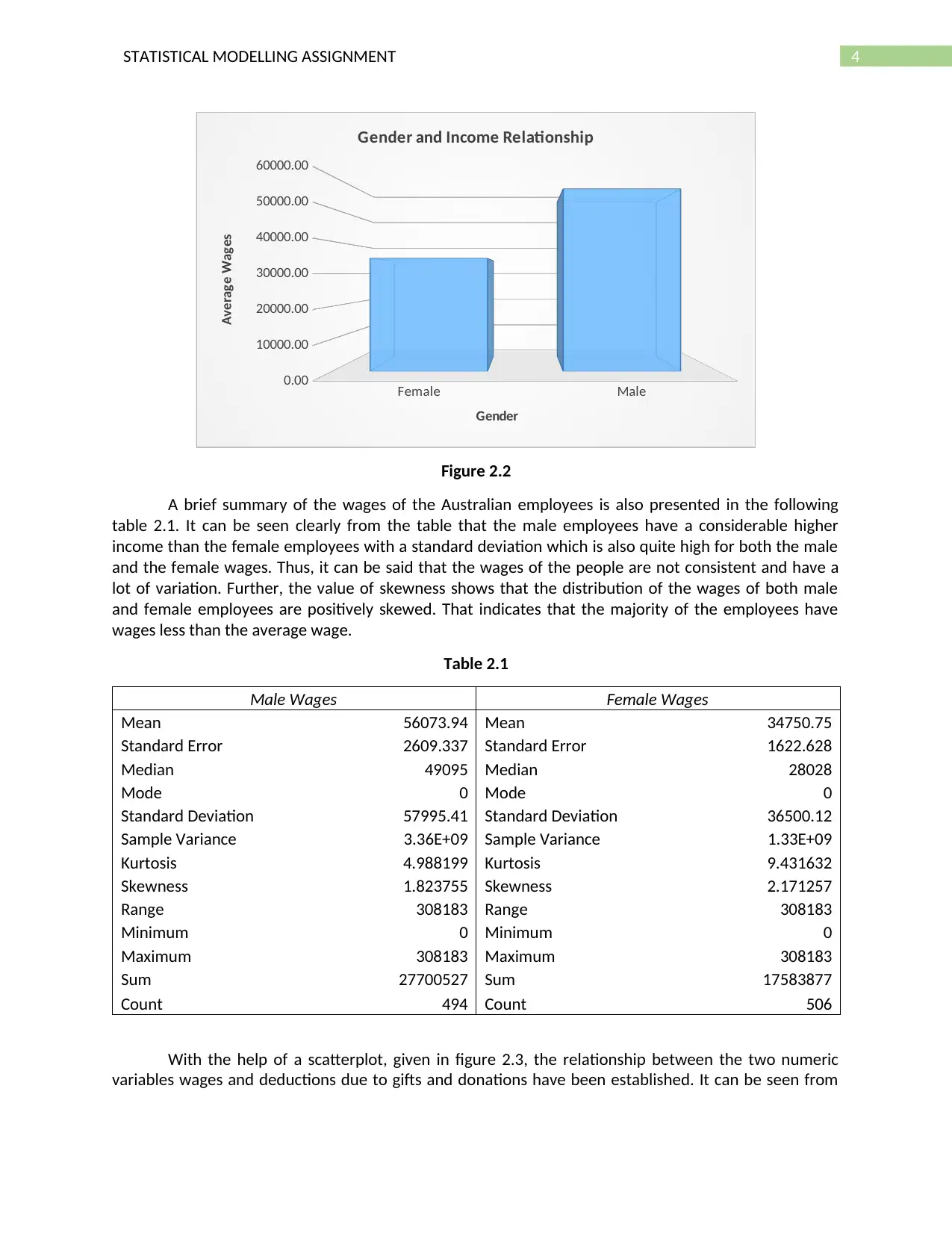
4STATISTICAL MODELLING ASSIGNMENT
Female Male
0.00
10000.00
20000.00
30000.00
40000.00
50000.00
60000.00
Gender and Income Relationship
Gender
Average Wages
Figure 2.2
A brief summary of the wages of the Australian employees is also presented in the following
table 2.1. It can be seen clearly from the table that the male employees have a considerable higher
income than the female employees with a standard deviation which is also quite high for both the male
and the female wages. Thus, it can be said that the wages of the people are not consistent and have a
lot of variation. Further, the value of skewness shows that the distribution of the wages of both male
and female employees are positively skewed. That indicates that the majority of the employees have
wages less than the average wage.
Table 2.1
Male Wages Female Wages
Mean 56073.94 Mean 34750.75
Standard Error 2609.337 Standard Error 1622.628
Median 49095 Median 28028
Mode 0 Mode 0
Standard Deviation 57995.41 Standard Deviation 36500.12
Sample Variance 3.36E+09 Sample Variance 1.33E+09
Kurtosis 4.988199 Kurtosis 9.431632
Skewness 1.823755 Skewness 2.171257
Range 308183 Range 308183
Minimum 0 Minimum 0
Maximum 308183 Maximum 308183
Sum 27700527 Sum 17583877
Count 494 Count 506
With the help of a scatterplot, given in figure 2.3, the relationship between the two numeric
variables wages and deductions due to gifts and donations have been established. It can be seen from
Female Male
0.00
10000.00
20000.00
30000.00
40000.00
50000.00
60000.00
Gender and Income Relationship
Gender
Average Wages
Figure 2.2
A brief summary of the wages of the Australian employees is also presented in the following
table 2.1. It can be seen clearly from the table that the male employees have a considerable higher
income than the female employees with a standard deviation which is also quite high for both the male
and the female wages. Thus, it can be said that the wages of the people are not consistent and have a
lot of variation. Further, the value of skewness shows that the distribution of the wages of both male
and female employees are positively skewed. That indicates that the majority of the employees have
wages less than the average wage.
Table 2.1
Male Wages Female Wages
Mean 56073.94 Mean 34750.75
Standard Error 2609.337 Standard Error 1622.628
Median 49095 Median 28028
Mode 0 Mode 0
Standard Deviation 57995.41 Standard Deviation 36500.12
Sample Variance 3.36E+09 Sample Variance 1.33E+09
Kurtosis 4.988199 Kurtosis 9.431632
Skewness 1.823755 Skewness 2.171257
Range 308183 Range 308183
Minimum 0 Minimum 0
Maximum 308183 Maximum 308183
Sum 27700527 Sum 17583877
Count 494 Count 506
With the help of a scatterplot, given in figure 2.3, the relationship between the two numeric
variables wages and deductions due to gifts and donations have been established. It can be seen from
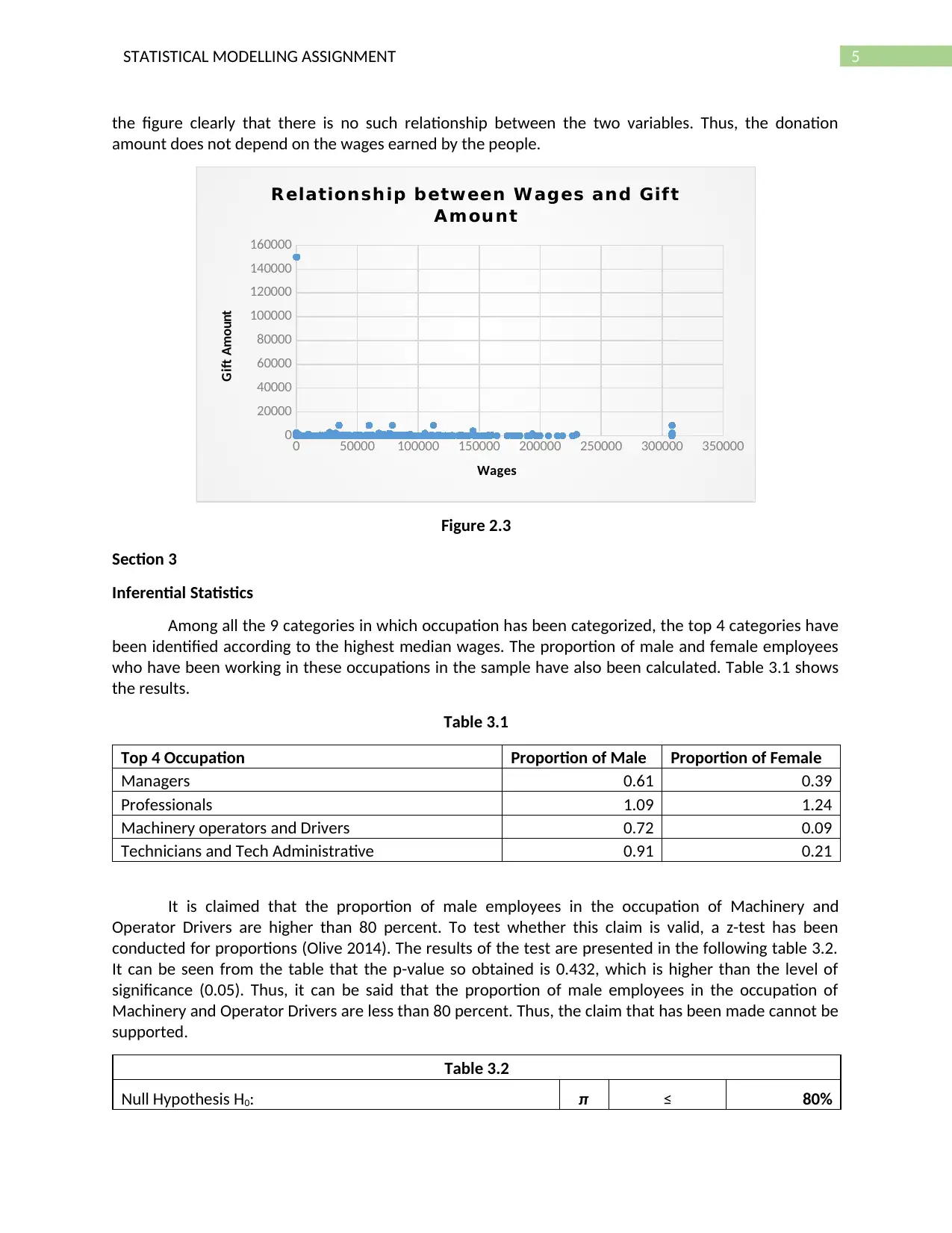
5STATISTICAL MODELLING ASSIGNMENT
the figure clearly that there is no such relationship between the two variables. Thus, the donation
amount does not depend on the wages earned by the people.
0 50000 100000 150000 200000 250000 300000 350000
0
20000
40000
60000
80000
100000
120000
140000
160000
R elationsh ip b etween W ages and Gift
A m ou nt
Wages
Gift Amount
Figure 2.3
Section 3
Inferential Statistics
Among all the 9 categories in which occupation has been categorized, the top 4 categories have
been identified according to the highest median wages. The proportion of male and female employees
who have been working in these occupations in the sample have also been calculated. Table 3.1 shows
the results.
Table 3.1
Top 4 Occupation Proportion of Male Proportion of Female
Managers 0.61 0.39
Professionals 1.09 1.24
Machinery operators and Drivers 0.72 0.09
Technicians and Tech Administrative 0.91 0.21
It is claimed that the proportion of male employees in the occupation of Machinery and
Operator Drivers are higher than 80 percent. To test whether this claim is valid, a z-test has been
conducted for proportions (Olive 2014). The results of the test are presented in the following table 3.2.
It can be seen from the table that the p-value so obtained is 0.432, which is higher than the level of
significance (0.05). Thus, it can be said that the proportion of male employees in the occupation of
Machinery and Operator Drivers are less than 80 percent. Thus, the claim that has been made cannot be
supported.
Table 3.2
Null Hypothesis H0: π ≤ 80%
the figure clearly that there is no such relationship between the two variables. Thus, the donation
amount does not depend on the wages earned by the people.
0 50000 100000 150000 200000 250000 300000 350000
0
20000
40000
60000
80000
100000
120000
140000
160000
R elationsh ip b etween W ages and Gift
A m ou nt
Wages
Gift Amount
Figure 2.3
Section 3
Inferential Statistics
Among all the 9 categories in which occupation has been categorized, the top 4 categories have
been identified according to the highest median wages. The proportion of male and female employees
who have been working in these occupations in the sample have also been calculated. Table 3.1 shows
the results.
Table 3.1
Top 4 Occupation Proportion of Male Proportion of Female
Managers 0.61 0.39
Professionals 1.09 1.24
Machinery operators and Drivers 0.72 0.09
Technicians and Tech Administrative 0.91 0.21
It is claimed that the proportion of male employees in the occupation of Machinery and
Operator Drivers are higher than 80 percent. To test whether this claim is valid, a z-test has been
conducted for proportions (Olive 2014). The results of the test are presented in the following table 3.2.
It can be seen from the table that the p-value so obtained is 0.432, which is higher than the level of
significance (0.05). Thus, it can be said that the proportion of male employees in the occupation of
Machinery and Operator Drivers are less than 80 percent. Thus, the claim that has been made cannot be
supported.
Table 3.2
Null Hypothesis H0: π ≤ 80%
⊘ This is a preview!⊘
Do you want full access?
Subscribe today to unlock all pages.

Trusted by 1+ million students worldwide
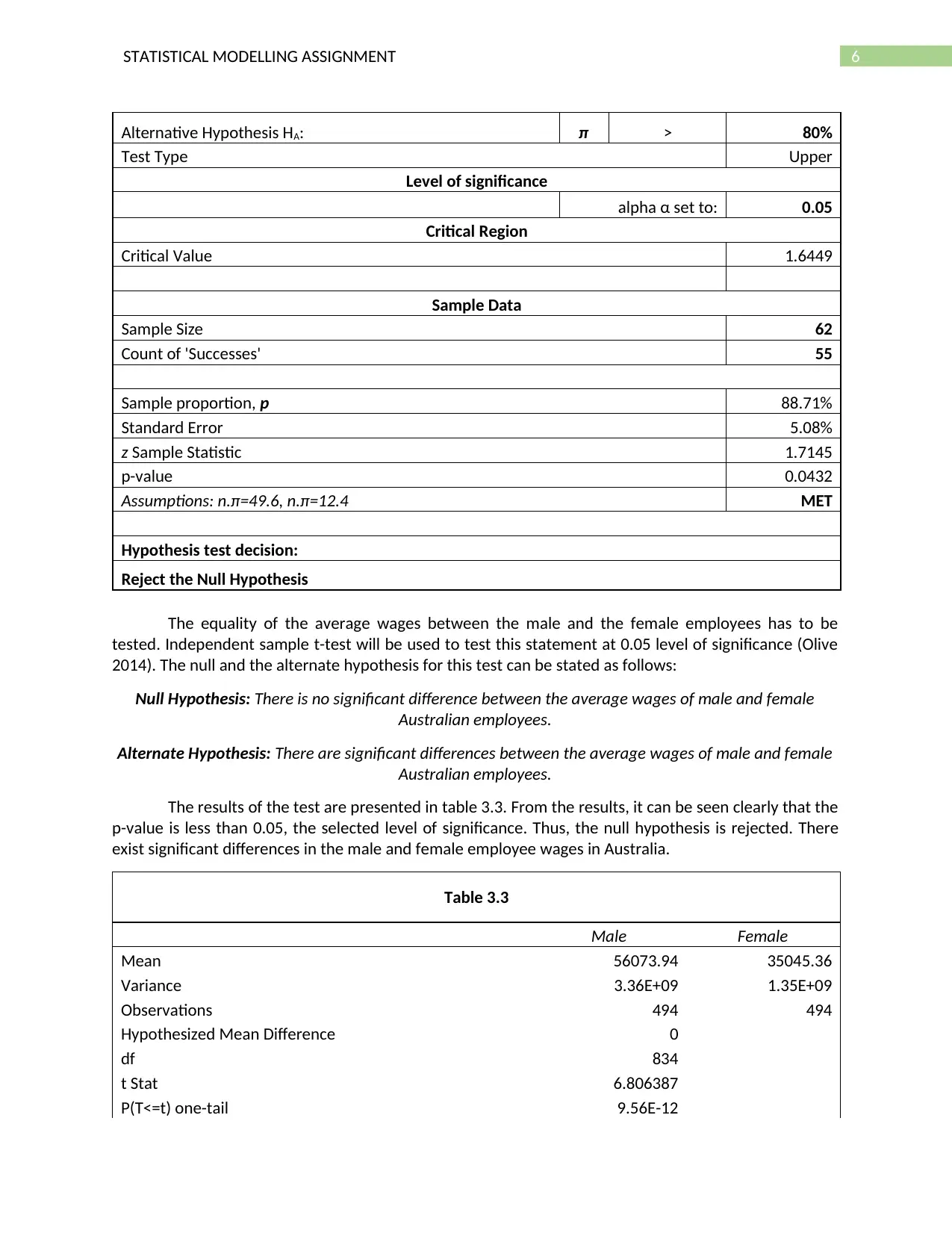
6STATISTICAL MODELLING ASSIGNMENT
Alternative Hypothesis HA: π > 80%
Test Type Upper
Level of significance
alpha α set to: 0.05
Critical Region
Critical Value 1.6449
Sample Data
Sample Size 62
Count of 'Successes' 55
Sample proportion, p 88.71%
Standard Error 5.08%
z Sample Statistic 1.7145
p-value 0.0432
Assumptions: n.π=49.6, n.π=12.4 MET
Hypothesis test decision:
Reject the Null Hypothesis
The equality of the average wages between the male and the female employees has to be
tested. Independent sample t-test will be used to test this statement at 0.05 level of significance (Olive
2014). The null and the alternate hypothesis for this test can be stated as follows:
Null Hypothesis: There is no significant difference between the average wages of male and female
Australian employees.
Alternate Hypothesis: There are significant differences between the average wages of male and female
Australian employees.
The results of the test are presented in table 3.3. From the results, it can be seen clearly that the
p-value is less than 0.05, the selected level of significance. Thus, the null hypothesis is rejected. There
exist significant differences in the male and female employee wages in Australia.
Table 3.3
Male Female
Mean 56073.94 35045.36
Variance 3.36E+09 1.35E+09
Observations 494 494
Hypothesized Mean Difference 0
df 834
t Stat 6.806387
P(T<=t) one-tail 9.56E-12
Alternative Hypothesis HA: π > 80%
Test Type Upper
Level of significance
alpha α set to: 0.05
Critical Region
Critical Value 1.6449
Sample Data
Sample Size 62
Count of 'Successes' 55
Sample proportion, p 88.71%
Standard Error 5.08%
z Sample Statistic 1.7145
p-value 0.0432
Assumptions: n.π=49.6, n.π=12.4 MET
Hypothesis test decision:
Reject the Null Hypothesis
The equality of the average wages between the male and the female employees has to be
tested. Independent sample t-test will be used to test this statement at 0.05 level of significance (Olive
2014). The null and the alternate hypothesis for this test can be stated as follows:
Null Hypothesis: There is no significant difference between the average wages of male and female
Australian employees.
Alternate Hypothesis: There are significant differences between the average wages of male and female
Australian employees.
The results of the test are presented in table 3.3. From the results, it can be seen clearly that the
p-value is less than 0.05, the selected level of significance. Thus, the null hypothesis is rejected. There
exist significant differences in the male and female employee wages in Australia.
Table 3.3
Male Female
Mean 56073.94 35045.36
Variance 3.36E+09 1.35E+09
Observations 494 494
Hypothesized Mean Difference 0
df 834
t Stat 6.806387
P(T<=t) one-tail 9.56E-12
Paraphrase This Document
Need a fresh take? Get an instant paraphrase of this document with our AI Paraphraser

7STATISTICAL MODELLING ASSIGNMENT
t Critical one-tail 1.646683
P(T<=t) two-tail 1.91E-11
t Critical two-tail 1.962812
The equality of the average wages between the male and the female employees has to be
tested once again from the data collected with the help of the survey. Independent sample t-test will be
used to test this statement at 0.05 level of significance. The null and the alternate hypothesis for this
test will be the same as the previous test.
The results of the test are presented in table 3.4. From the results, it can be seen clearly that the
p-value is less than 0.05, the selected level of significance. Thus, the null hypothesis is rejected. There
exist significant differences in the male and female employee wages in Australia.
Table 3.4
Male Female
Mean 56282.47 46768.19
Variance 5.61E+09 2.35E+09
Observations 19 21
Hypothesized Mean Difference 0
df 30
t Stat 0.471356
P(T<=t) one-tail 0.320398
t Critical one-tail 1.697261
P(T<=t) two-tail 0.640796
t Critical two-tail 2.042272
Section 4
Discussion and Conclusion
It can be concluded from the analysis conducted so far that there has been no observed
evidence that can claim there is no gender discrimination in Australia. The wages of the female
employees are significantly less than the male employees. This result has been obtained by analyzing
both the primary and the secondary data. Thus, it can be said there are no factors which can claim that
gender discrimination does not exist in Australia.
From the secondary dataset, there is one variable whose impact have not been tested on the
male and female wages. This research study has one limitation. The difference in the male and the
female wages have not been tested for each of the different types of occupation. This can be further
tested from the given dataset to have a better understanding about the presence of gender
discrimination in Australia.
t Critical one-tail 1.646683
P(T<=t) two-tail 1.91E-11
t Critical two-tail 1.962812
The equality of the average wages between the male and the female employees has to be
tested once again from the data collected with the help of the survey. Independent sample t-test will be
used to test this statement at 0.05 level of significance. The null and the alternate hypothesis for this
test will be the same as the previous test.
The results of the test are presented in table 3.4. From the results, it can be seen clearly that the
p-value is less than 0.05, the selected level of significance. Thus, the null hypothesis is rejected. There
exist significant differences in the male and female employee wages in Australia.
Table 3.4
Male Female
Mean 56282.47 46768.19
Variance 5.61E+09 2.35E+09
Observations 19 21
Hypothesized Mean Difference 0
df 30
t Stat 0.471356
P(T<=t) one-tail 0.320398
t Critical one-tail 1.697261
P(T<=t) two-tail 0.640796
t Critical two-tail 2.042272
Section 4
Discussion and Conclusion
It can be concluded from the analysis conducted so far that there has been no observed
evidence that can claim there is no gender discrimination in Australia. The wages of the female
employees are significantly less than the male employees. This result has been obtained by analyzing
both the primary and the secondary data. Thus, it can be said there are no factors which can claim that
gender discrimination does not exist in Australia.
From the secondary dataset, there is one variable whose impact have not been tested on the
male and female wages. This research study has one limitation. The difference in the male and the
female wages have not been tested for each of the different types of occupation. This can be further
tested from the given dataset to have a better understanding about the presence of gender
discrimination in Australia.

8STATISTICAL MODELLING ASSIGNMENT
References
Tomaskovic-Devey, D. and Avent-Holt, D., 2016. Observing organizational inequality regimes. In A
Gedenkschrift to Randy Hodson: Working with Dignity (pp. 187-212). Emerald Group Publishing Limited.
Olive, D.J., 2014. Testing Statistical Hypotheses. In Statistical Theory and Inference (pp. 183-213).
Springer, Cham.
References
Tomaskovic-Devey, D. and Avent-Holt, D., 2016. Observing organizational inequality regimes. In A
Gedenkschrift to Randy Hodson: Working with Dignity (pp. 187-212). Emerald Group Publishing Limited.
Olive, D.J., 2014. Testing Statistical Hypotheses. In Statistical Theory and Inference (pp. 183-213).
Springer, Cham.
⊘ This is a preview!⊘
Do you want full access?
Subscribe today to unlock all pages.

Trusted by 1+ million students worldwide
1 out of 9
Related Documents
Your All-in-One AI-Powered Toolkit for Academic Success.
+13062052269
info@desklib.com
Available 24*7 on WhatsApp / Email
![[object Object]](/_next/static/media/star-bottom.7253800d.svg)
Unlock your academic potential
Copyright © 2020–2025 A2Z Services. All Rights Reserved. Developed and managed by ZUCOL.





